A Bigger, Better Brain
By Craig Stanford, Maddalena Bearzi
Observations of chimpanzees and dolphins strengthen the notion that humanlike intelligence may not be uniquely human
Observations of chimpanzees and dolphins strengthen the notion that humanlike intelligence may not be uniquely human

DOI: 10.1511/2010.86.402
When the orange sun rises in the east of Gombe National Park in Tanzania, it takes time to cross the mountain ridge above and warm the forest below. There, a party of chimpanzees is waking up. One by one they roll over, look up at the morning sky and slowly revive themselves.
Each sits sleepily on the branch supporting his or her nest, peeing quietly onto the ground many meters below. Every tree has an ape or two, and one towering Chrysophyllum tree holds several nests. In minutes, the silent band descends to sit like boulders on the hillside.
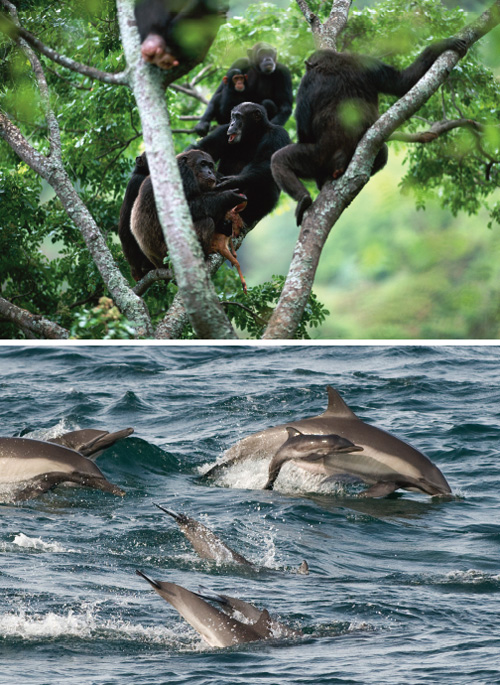
Photograph at top: Anup Shah/naturepl.com Photograph at bottom: Mark Carwardine/naturepl.com
Then, as if on cue, one of the older males gets up and begins walking from the sleeping area, heading north. Several males follow, but two walk instead to the west toward a lake. A mother and her infant embark southward, alone. A couple of young males stay put; later they will travel to the east, up into the rugged hills. What started out at dawn as a nesting party of 26 chimpanzees fragments into at least five separate parties of one to eight chimpanzees each, all venturing into a day of multiple decisions and complicated social encounters.
At the opposite side of the world, dawn begins to light up the coast of the Yucatan Peninsula in Mexico. Like clockwork, a group of dolphins passes the fisherman’s rickety wharf at this time. Gordo, a chubby male bottlenose with a clear, deep notch halfway down his dorsal fin, is the first to appear in the morning mist. He makes his way slowly westward along the shoreline; the rest of the gang, a football field behind, follows. As the sun brightens, one dark grey body after another passes the pier. They are 14: a female with her calf and 12 others. Twenty or so meters past the wharf, they cluster together next to a colorful string of moored pangas. Some dive, others mill about at the surface.
A few at a time, the dolphins explore the sandy bottom with no sign of hurry while another group of dolphins leisurely joins them from the opposite direction. They are now 23 with a couple of calves next to their mothers, all tightly grouped in a murky patch of water that likely hides a fishy meal. Suddenly, the circle unwinds in two lively threads: Five animals move steadily back toward the wharf in a monklike procession; the others disappear quickly to the west. The sun is already high on the horizon. What seemed for a moment to be a singular and cohesive group has reshuffled and divided, ready for the complex tasks and interactions that will make up their day.
Chimpanzees and dolphins look completely different. One resembles people, more or less. The other has the body of a cruise missile. One has hands that can skillfully manipulate a tool, delicately groom a partner or converse in sign language. The other has no hands at all. Chimpanzees swing through the trees of African forests. Dolphins dive deep in oceans. These mammals, about as closely related as mice and elephants, haven’t had a common ancestor for nearly 100 million years. It takes dissection to see how their organs and limbs share common features.
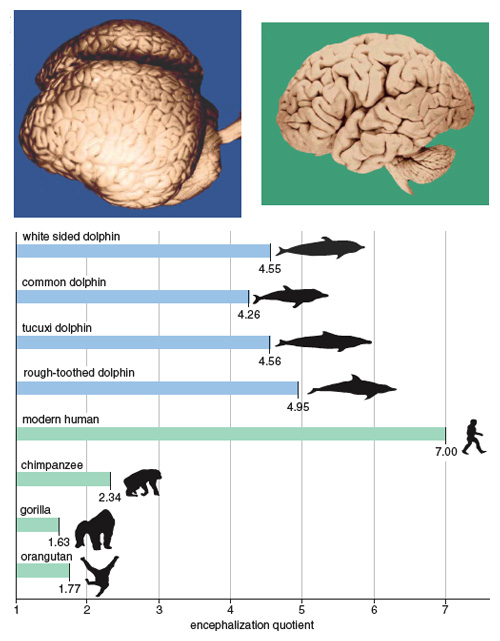
One of us (Maddalena) is a marine mammalogist who has studied bottlenose and other dolphin species for nearly 20 years in Santa Monica Bay, near Los Angeles, and other parts of the world. The other (Craig) is a primatologist who has observed chimpanzees and gorillas in Africa for more than 15 years. As unlikely as it might seem, we find more parallel behavioral traits in these species than we do in more closely related animals. What’s even more compelling is that many of these distinctive traits are also found in humans—an observation that may have implications for the origin of human intelligence.
Humanlike intelligence may not be a quality that could only have emerged from our own recent evolutionary lineage. Instead convergent evolution could have played a role. Evidence for this argument is not yet irrefutable but it is increasing. And it all starts with one unusual quality shared by humans, chimpanzees and dolphins: the large size of their brains. The various dolphin species, the four great apes and Homo sapiens possess brains that are the cognitive crowning glory of Earth’s millions of species.
Of all the species on our planet, only a handful has possessed a high degree of intellect: apes and humans (including many extinct forms of both), dolphins, whales, and some others, such as elephants. The brains of an ape and a dolphin differ in their external morphology and neuroanatomical organization, in particular their cortical cytoarchitecture, which in dolphins has less cellular differentiation. Despite these differences, primate (including human) and dolphin brains share important similarities. For one, the brains of dolphins and apes increased in size and complexity over their evolutionary history. Both possess a high encephalization quotient (EQ) due to their unusually large brain-to-body-size ratios. EQ is the ratio of an animal’s actual brain size to its expected brain size based on measurements of other animals its size. In both dolphins and apes, the neocortex is also more elaborately developed compared to that of other animals. Also distinctive is the neocortical gyrification, or folding of the cerebral cortex—which in dolphins surpasses that of any primate—and the presence of spindle-shaped neurons, called Von Economo neurons, which have been linked in people to social fluency and the ability to sense what others think. Only recently were those neurons found in bottlenose dolphins.

Illustration by Tom Dunne.
But why is a big, sophisticated brain an advantage in life? Dinosaurs had puny brains but flourished for hundreds of millions of years. Intelligence is an adaptation, but not necessarily the only or even the most effective one. What works best for a given organism depends on its environmental context. Some creatures have changed precious little over many millions of years. Other lineages, such as primates and cetaceans, have undergone dramatic changes and a mushrooming of brain size in just a few million years. Natural selection has acted to favor intelligence when it conferred survival and reproductive benefits and when it complimented traits that were genetically hard-wired.
Brain power has allowed dolphins and apes to possess communication and social skills so complex that we are only now beginning to understand how they work. Unlike most animals, apes and dolphins live in fluid societies and engage in relationships that require accurate memories of who is a friend and who owes whom a favor. The social alliances they become a part of can change as their needs change. Great apes possess an intellect often referred to as Machiavellian. They remember favors owed and debts incurred and they operate in a “service economy” of behavior exchange. Male chimpanzees form paramilitary patrol parties and hunting parties. They also shift alliances in accordance with their self-interest. They may work with one group to manipulate a female for sexual access and with another to overthrow an alpha male. We used to think that some of these alliances were based entirely on kinship. Anthony Goldberg and Richard Wrangham showed some years ago, however, that such coalitions are not necessarily based on genetic relatedness.

Photograph courtesy of the Chicago Zoological Society’s Sarasota Dolphin Research Program.
Some dolphins also form coalitions of males in order to sexually coerce females. As was very recently observed by David Lusseau of the University of Aberdeen in Scotland, these groupings can also cooperate to overthrow other male coalitions. The alliances allow for highly complex behavioral “agreements” between males of the same school who cooperate in pairs and triplets to sequester females likely to be in estrus. In other contexts, dolphins can also practice deceit and deception, practices that require a theory of mind—the ability to perceive mental states in oneself and in others. Stan Kuczaj of the University of Southern Mississippi and his colleagues observed intentional deception in Kelly, a female dolphin kept in captivity. Kelly had been trained—along with her tank-mates—to retrieve objects from the pool in exchange for fish. After all the other dolphins had finished with their retrieval chores and gone their own way, Kelly appeared at the surface with some objects of unknown origin in the hope of gaining more fish. After searching the pool, Kelly’s trainer discovered a secret cache of “toys” that the dolphin had astutely concealed under a drain cover. Day after day, she had collected objects inadvertently dropped into the pool by tourists, to be used for barter with her trainers for fish. On closer observation, it also became clear that Kelly was extremely careful not to add or remove objects from her cache when other dolphins were present.
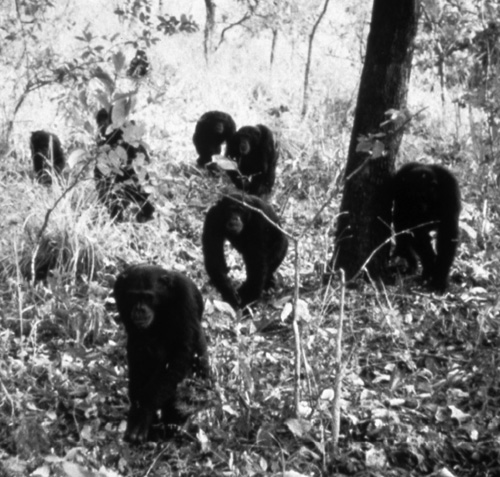
Photograph courtesy of the Jane Goodall Institute.
Great apes also seem to be skilled at deceiving one another. In Tanzania, one of us (Craig) once watched a low-ranking male chimpanzee named Beethoven use deception to mate with a female despite the presence of the alpha male called Wilkie. As a party of chimpanzees sat in a forest clearing, Beethoven made a charging display through the middle of the group, his hair standing on end and his arched posture indicating bravado. As a low-ranking male, this was taken by the alpha Wilkie as an act of insubordination. As Beethoven charged past Wilkie and into dense thickets, Wilkie pursued and launched into his own display, dragging branches, drumming tree trunks with his feet and generally trying to be maximally impressive. With Wilkie absorbed in his display of dominance, Beethoven furtively made his way back to the clearing and mated with an eagerly awaiting female.
Our understanding of how chimpanzees and dolphins apply their intelligence to tool use is expanding as well. Jane Goodall and others showed decades ago that chimpanzees use sticks to harvest insects. A 2007 report by primatologist Jill Pruetz taught us more: She and her colleagues, working in Senegal, observed a chimpanzee use a stick it had peeled to a tapered end as a weapon to hunt another mammal, something once only seen in humans. The chimpanzee jabbed the stick into tree cavities until it found a bushbaby, a squirrel-sized primate, which the stick extracted. Although not exactly a spear, the stick was evidence that the chimpanzee had foreseen a problem in immobilizing and extracting its intended prey and had devised a solution.
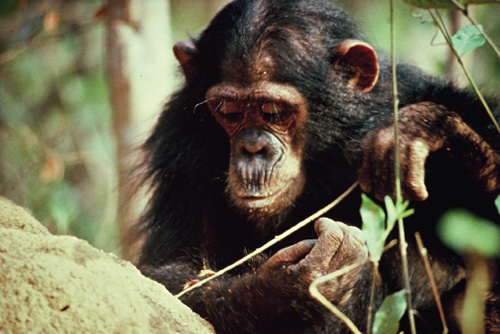
Photograph courtesy of Craig Stanford.
Dolphins do not have hands to use tools, but wild Indian Ocean bottlenose dolphin females are the first “tool-using cetacean” ever documented. Marine biologist Rachel Smolker and colleagues in the early 1980s observed these animals carrying a large cone-shaped sponge on the tip of their elongated beaks, or rostra, like a mask. These “nose mittens” were used for protection against stinging organisms or sand abrasion, or to extract prey from the sea floor. In a 2005 publication, Michael Krützen of the University of Zurich and his colleagues, using mitochondrial DNA analyses, concluded that “sponging” was socially transmitted vertically within a single matrilineal group, from mother sponge-carriers to their female offspring.
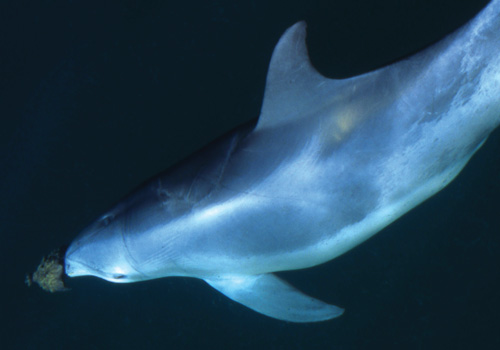
Photograph courtesy of Michael Heithaus of Florida International University.
Knowing how to use a tool is not the fundamental adaptation that a large brain provides. Instead, a large brain conveys the ability to learn and to imitate another’s behavior to appropriate its benefits. Tools allow chimpanzees to harvest protein, fat and carbohydrates that would be otherwise unavailable. The added nutrition can help a gestating or lactating female through an otherwise lean time of year, and enhance her reproductive output over the course of her long life. The ability to respond to rapidly changing dynamics in the social group, such as when males form coalitions to control females, is not limited to higher primates and dolphins, but it certainly typifies many species among them. In each case, these skills require years of learning. But the payoff is a potential reproductive windfall.
For many years the study of chimpanzee technological culture consisted mostly of anecdotes, which are fascinating but not always convincing. But when chimpanzee researchers obtained enough long-term data that they were able to analyze cultural traditions from a range of field sites, they found unequivocal evidence for a systematic pattern of these traditions. Using tool use and other cultural data from the seven longest-running field studies in Africa, Andrew Whiten of the University of St. Andrews and his colleagues in 1999 found at least 39 behaviors that could be attributable to the influence of learned traditions. This number may seem rather limited compared with the myriad examples of such behavior in our species, where almost everything is learned at some level. But compared with other nonhuman animals, it is a long list. The logical conclusion here is that animals that live by their wits, as it were, tend to be like chimpanzees and us—big-brained and with a long period of growth and maturation during which key life skills can be acquired by watching one’s elders and peers.
We can ask how and why certain cultural traditions, whether technological or social behavior, arise and spread. Biological evolution occurs primarily via natural selection and is preserved though the transfer of genetic material from one generation to the next. It is also an inefficient process, because of the time required for genes to pass to the next generation, and because each reproductive act requires (in all higher animals) the reshuffling of genes from mother and father. Cultural “evolution” does not require the massive shuffling of the genetic deck that can slow the rate of change to a glacial pace. If a cultural trait confers on its user higher odds of survival and enhanced reproduction, then it has a good chance of being passed on. Even though the tool-use innovation, for example, has no genetic basis, the tradition of its use, once established, should spread, to the reproductive benefit of the inventor. Thus an entirely nongenetic feature could have a long-term effect on the species. Only a few groups of animals on this planet exhibit cultural traits. Higher primates certainly are cultural animals. Cetaceans also exhibit elements of culture. A good example of social learning in dolphins is the vertical cultural transmission of foraging and feeding specializations and vocal dialects. John Ford, for instance, reported what he calls “interpod call mimicry” in the wild, showing that killer whales are capable of vocal learning.
Scientists disagree about whether dolphins have language capabilities but evidence persists that they may, depending on how one defines it. In one of the best-known cases, Louis Herman and his colleagues at the Kewalo Basin Marine Mammal Lab in Honolulu in the 1980s devised two artificial languages to teach to bottlenose dolphins at their facility. Neither language approximated human conversation, but both were based on a set of grammatical rules. One was computer-generated and included high-pitched words. The other was a sign language conveyed by trainers’ arm and hand signals.

In an underwater classroom, two animals, Ake and Phoenix, were taught a series of sentences, including some commands describing how to take a Frisbee through a particular hoop or to swim under another dolphin. The dolphins also displayed the ability to recognize meaningless phrases. When a trainer occasionally said something that didn’t make sense in the created languages, for instance, Ake ignored the command.
Evidence that apes can acquire and use language, including sign language, has grown over decades. Perhaps the most persuasive evidence of language capability in nonhuman apes comes from primatologist Sue Savage- Rumbaugh, who for 30 years was affiliated with Georgia State University’s Language Research Center. Kanzi, a male bonobo she worked with, learned to communicate by touching symbols on a lexicon board and understand some spoken English. Savage-Rumbaugh estimated he could produce 300 words himself and could understand more than 1,000 when spoken.
Work by Savage-Rumbaugh and many other researchers has conclusively settled at least two arguments over ape language. First, she demonstrated that apes understand and employ the concept of reference, using words as symbols to represent things in their environment. Second, they can spontaneously use and combine these words to make requests, give information and comment on the world around them. If there is a difference between what Kanzi comprehends and what a human toddler understands, scientists have not yet discovered it.
Evidence also exists that dolphins and chimpanzees can recognize themselves as individuals. Chimpanzees, gorillas, bonobos and orangutans not only recognize themselves in mirrors but also are able to understand that paint blotches they observe in mirrors during experiments were placed on their bodies. The same holds true for bottlenose dolphins. These experiments do not prove that the animals are self-aware in human terms. But they do provide evidence that these animals exhibit cognition, as does their behavior in the wild.
Large brains likely also help these animals succeed in foraging. Both chimpanzees and dolphins feed on widely scattered, temporarily available food. Many species of dolphins chase schools of fish; chimpanzees chase the fleeting appearances of ripe fruits in tree crowns. These two dietary specialties keep them moving all day long, in search of the next school, the next patch. Predicting where and when to search is one challenge. Chimpanzees have the spatial memory of forest rangers. They monitor particular fruit trees in the weeks leading up to the ripening of a crop and return to the right spot day after day until the bounty is gone. Dolphins have a taller order; they have to know where to locate rapidly moving fish schools without such obvious landmarks as trees, streams and mountains. For this they have sonar, a wonderfully evolved system that humans only relatively recently were able to replicate for their own uses. But in addition to their purely sensory adaptations, dolphins put their intelligence (and memory) to good use to find fish.
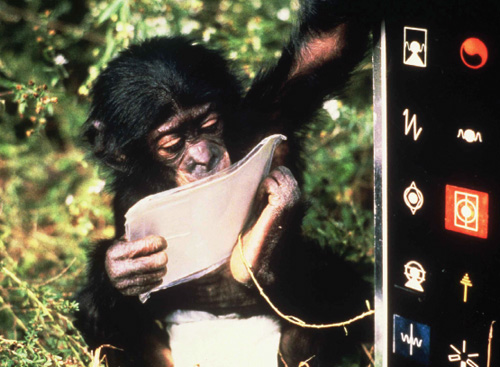
Image from globalfiredata.org.
Chimpanzees mostly eat fruit but, like dolphins, they do hunt. And their hunting is social. They will attack groups of monkeys they encounter during their rambles in search of fruit in African forests. The chase, capture and kill are heart stopping, often gruesome, and always illustrative of the chimpanzees’ social nature. To a lion, the zebra it is chasing may be only a meal, but to a chimpanzee the chance to kill and share prey is not only nutritional, but socially significant as well. The monkeys and pigs and antelopes the chimpanzees capture sometimes become pawns in the social dynamics of the group. Researchers in a range of studies across Africa have shown that males use meat to negotiate new alliances, rub salt in the wounds of old rivals and secure status that a chimpanzee without prey cannot. Adult and adolescent males do most of the hunting, making about 90 percent of the kills recorded at Gombe. Females also hunt but more often receive a share of meat from the male who either captured the meat or stole it from the captor. Although lone chimpanzees, both male and female, sometimes hunt by themselves, most hunts are social.
For many dolphin species, hunting is also a social affair. Dolphins are efficient predators who use both agility and braininess to achieve success. Killer whales, the largest dolphins, display one of the most cooperative hunting practices. Feeding at the top of the food chain, transient killer whales prey on small marine mammals such as seals lying on beaches or slabs of ice, and scientists have observed coordinated and intentional stranding by killer whales in the waters of Patagonia. On occasion, the killing of a pinniped represents a learning lesson for the calf, which will use the same technique throughout its life. In groups, they also attack whales much larger than themselves without any sign of fear or hesitation and with a high degree of predatory success.
Being such accomplished ocean hunters makes dolphins a valuable asset for other ocean dwellers in search of a meal. In the coastal waters of Los Angeles, one of us (Maddalena) frequently observes sea lions in proximity to dolphins during feeding and foraging activities. Two predatory species travel and feed together, with no evident hostility or competition. Sea lions capitalize on the superior food-finding ability of echolocating common dolphins to find their own prey. The diverse hunting strategies employed by dolphin and ape societies are an excellent gauge of their social complexity, and another example of how brain complexity, social complexity and ecological complexity are all linked.
These growing insights into the intelligence of great apes and dolphins are emerging as these animals become increasingly threatened worldwide. As we reach farther and farther into tropical forests in search of timber, farmland and spaces for human dwellings, we disrupt the apes’ terrestrial habitat. The ongoing hunting of these animals is also taking a toll. And as we continue to use the oceans as our dumping ground, we threaten dolphins’ habitat. The incidental catching of nontarget species in commercial fishing activity, known as bycatch, is just one of the major problems facing these animals today. Many conservationists believe that a century from now, great apes will live only in a few carefully protected sanctuaries or in captivity. Dolphin populations are much less visible than those of great apes but the threats to them are also insidious. Today, several dolphin species are either critically endangered, endangered, threatened or of unknown status.
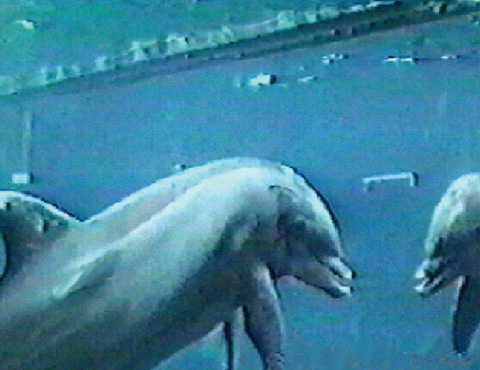
Photograph courtesy of Diana Reiss.
As scientists who have spent many years studying dolphins and apes in the wild, we believe that our research must incorporate respect and a sense of stewardship for the animals we study. We have both reached the same conclusion: Without conservation and protection of these species and the ecosystems in which they live, they will not survive to see the next century. Sadly, this projection comes just as we are beginning to better understand their complex abilities and social interactions.
Click "American Scientist" to access home page
American Scientist Comments and Discussion
To discuss our articles or comment on them, please share them and tag American Scientist on social media platforms. Here are links to our profiles on Twitter, Facebook, and LinkedIn.
If we re-share your post, we will moderate comments/discussion following our comments policy.